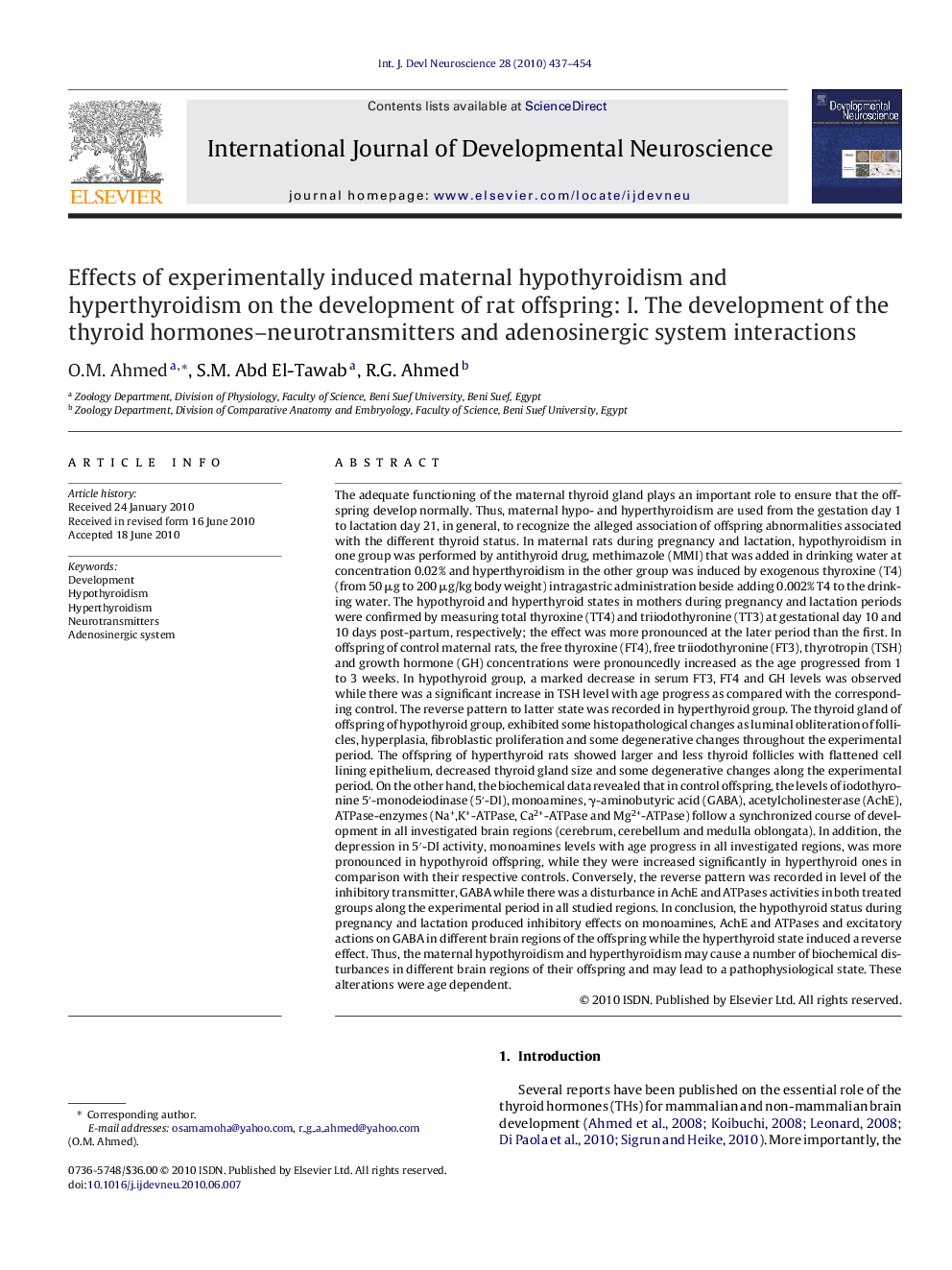| کد مقاله | کد نشریه | سال انتشار | مقاله انگلیسی | نسخه تمام متن |
|---|---|---|---|---|
| 2786600 | 1568426 | 2010 | 18 صفحه PDF | دانلود رایگان |

The adequate functioning of the maternal thyroid gland plays an important role to ensure that the offspring develop normally. Thus, maternal hypo- and hyperthyroidism are used from the gestation day 1 to lactation day 21, in general, to recognize the alleged association of offspring abnormalities associated with the different thyroid status. In maternal rats during pregnancy and lactation, hypothyroidism in one group was performed by antithyroid drug, methimazole (MMI) that was added in drinking water at concentration 0.02% and hyperthyroidism in the other group was induced by exogenous thyroxine (T4) (from 50 μg to 200 μg/kg body weight) intragastric administration beside adding 0.002% T4 to the drinking water. The hypothyroid and hyperthyroid states in mothers during pregnancy and lactation periods were confirmed by measuring total thyroxine (TT4) and triiodothyronine (TT3) at gestational day 10 and 10 days post-partum, respectively; the effect was more pronounced at the later period than the first. In offspring of control maternal rats, the free thyroxine (FT4), free triiodothyronine (FT3), thyrotropin (TSH) and growth hormone (GH) concentrations were pronouncedly increased as the age progressed from 1 to 3 weeks. In hypothyroid group, a marked decrease in serum FT3, FT4 and GH levels was observed while there was a significant increase in TSH level with age progress as compared with the corresponding control. The reverse pattern to latter state was recorded in hyperthyroid group. The thyroid gland of offspring of hypothyroid group, exhibited some histopathological changes as luminal obliteration of follicles, hyperplasia, fibroblastic proliferation and some degenerative changes throughout the experimental period. The offspring of hyperthyroid rats showed larger and less thyroid follicles with flattened cell lining epithelium, decreased thyroid gland size and some degenerative changes along the experimental period. On the other hand, the biochemical data revealed that in control offspring, the levels of iodothyronine 5′-monodeiodinase (5′-DI), monoamines, γ-aminobutyric acid (GABA), acetylcholinesterase (AchE), ATPase-enzymes (Na+,K+-ATPase, Ca2+-ATPase and Mg2+-ATPase) follow a synchronized course of development in all investigated brain regions (cerebrum, cerebellum and medulla oblongata). In addition, the depression in 5′-DI activity, monoamines levels with age progress in all investigated regions, was more pronounced in hypothyroid offspring, while they were increased significantly in hyperthyroid ones in comparison with their respective controls. Conversely, the reverse pattern was recorded in level of the inhibitory transmitter, GABA while there was a disturbance in AchE and ATPases activities in both treated groups along the experimental period in all studied regions. In conclusion, the hypothyroid status during pregnancy and lactation produced inhibitory effects on monoamines, AchE and ATPases and excitatory actions on GABA in different brain regions of the offspring while the hyperthyroid state induced a reverse effect. Thus, the maternal hypothyroidism and hyperthyroidism may cause a number of biochemical disturbances in different brain regions of their offspring and may lead to a pathophysiological state. These alterations were age dependent.
Research highlights▶ The current study highlights the alterations in brain development during the early postnatal period in rat offspring of control, hypothyroid and hyperthyroid mothers. ▶ This study assesses the effects of maternal hypo- and hyperthyroidism on the histoarchitecture and function of thyroid gland and various biochemical parameters in different brain regions (cerebrum, cerebellum and medulla oblongata) of rat offspring at the end of the 1st, 2nd and 3rd postnatal weeks. ▶ It can be concluded from the study that the hypothyroid status during pregnancy and lactation produced inhibitory effects on monoamines, AchE and ATPases and excitatory actions on GABA in different brain regions of the offspring while the hyperthyroid state induced a reverse effect. ▶ Thus, the maternal hypothyroidism and hyperthyroidism may cause a number of biochemical disturbances in different brain regions of their offspring and may lead to a pathophysiological state. ▶ These alterations were age dependent.
Journal: International Journal of Developmental Neuroscience - Volume 28, Issue 6, October 2010, Pages 437–454